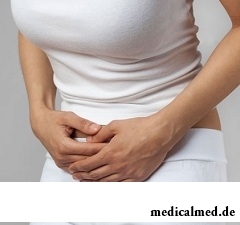





Dysmenorrhea
Dysmenorrhea – the pathological process which is characterized by the severe pains during periods which are absent throughout other cycle. Distinguish two types of disturbances: primary dysmenorrhea and secondary dysmenorrhea. Primary dysmenorrhea is diagnosed in cases when the reasons of painful periods are not established. The dysmenorrhea develops at 45-60% of women of childbearing age. For the first time the dysmenorrhea can be shown in the first ovulatory menstrual cycle, significantly reducing the level of vital activity and efficiency of the woman. The dysmenorrhea meets at the women of an asthenic constitution inclined to a loss of consciousness, irritable more often. The disease is also characteristic of patients with vegeto-vascular dystonia and an asthenoneurotic syndrome.
Primary dysmenorrhea
Primary dysmenorrhea – the functional disturbance of a menstrual cycle which is not caused by pathological processes in bodies of a small pelvis. Primary dysmenorrhea develops at youthful age and can be shown both during the first menstrual cycle, and 1-3 years later after the beginning of periods. As a rule, pains at such dysmenorrhea are tolerant, with age painful feelings can amplify. According to character and expressiveness of pains at primary dysmenorrhea allocate two forms: the compensated and noncompensated dysmenorrhea.
The compensated dysmenorrhea is characterized by an invariance of painful feelings eventually whereas the noncompensated dysmenorrhea is characterized by the amplifying pains eventually. As a rule, at the second form of a dysmenorrhea of the patient cannot do without the qualified medical care.
Pain at a dysmenorrhea can develop in 1-2 days prior to estimated periods, and also remain for the first days of a menstrual cycle. In most cases at a dysmenorrhea of pain have the skhvatkoobrazny, aching, pulling character. The pains of arching character irradiating in a rectum, area of a bladder, appendages are in rare instances observed.
Secondary dysmenorrhea
Secondary dysmenorrhea – the pathological process caused by disturbances of functioning of bodies of a small pelvis, inflammatory processes, gynecologic diseases. The secondary dysmenorrhea is, as a rule, diagnosed for patients after 30 years. The secondary dysmenorrhea meets in 27-33% of cases of total number of the diagnosed diseases, has more difficult character. At a secondary dysmenorrhea the period of loss of efficiency of the patient considerably increases. Painful feelings begin approximately a day before estimated periods. This type of a dysmenorrhea is characterized by plentiful menstrual bleeding with existence of a large number of clots, severe pains in a waist.
Dysmenorrhea: causes of illness
At primary dysmenorrhea of the reason of development of disturbance can be both physiological, and psychological character. At a dysmenorrhea development of the PGE2 (E2 prostaglandin) and the PGE2-alpha (E2 alpha prostaglandin) promoting reduction of smooth muscles and strengthening painful feelings can be the cause of painful feelings. At primary form of a dysmenorrhea of the reason can be covered in disturbance of a hormonal background.
The psychological reason of development and strengthening of painful feelings at a dysmenorrhea during periods is the fear of the patient of pain. So, anticipation of pain aggravates her perception.
At a secondary form of a dysmenorrhea causes of infringement can become:
- Expansion of pelvic veins;
- Inflammatory diseases of bodies of a small pelvis;
- Tumors of bodies of a small pelvis;
- Commissural processes after an operative measure;
- Endometriosis;
- Dysplasia;
- Hormonal disturbances in an organism;
- Intrauterine spiral;
- Diseases, sexually transmitted.
Dysmenorrhea: disturbance symptoms
Each of forms of a dysmenorrhea is characterized by a complex of symptoms according to which the diagnosis is made. At primary form of a dysmenorrhea symptoms are shown as follows:
- Pains of various character;
- Nausea, vomiting, dizziness, general weakness;
- Fervescence;
- Red spots on skin of hands, necks, persons;
- Locks;
- Disturbance of cordial rhythms;
- Sleep disorders, sleeplessness.
These symptoms of a dysmenorrhea are caused by increase in level of hormones of adrenaline, dopamine, noradrenaline and define adrenergic type of a dysmenorrhea.
Also at a dysmenorrhea symptoms can be caused by increase in level of hormone of serotonin that brings to:
- To heartbeat reduction in the frequency;
- To vomiting, diarrhea;
- To fall of temperature of a body.
These symptoms define parasympathetic type of a dysmenorrhea.
At a secondary dysmenorrhea symptoms can be added with symptomatology of the basic disease which is the reason of painful monthly.
In certain cases at a dysmenorrhea a symptom is painful sexual intercourse.
Diagnosis of a dysmenorrhea
The main diagnostic methods of a dysmenorrhea are the clinical picture and complaints of the patient to characteristic painful feelings. Also for an exception of the possible reasons of development of a dysmenorrhea ultrasonography of bodies of a small pelvis, a smear, the analysis of the hormonal status, hysteroscopy (survey of walls of a uterus by means of the special device, allows to reveal any intrauterine deviations, it is carried out in the conditions of a hospital), a laparoscopy is carried out (survey of abdominal organs by means of the special device, surgical intervention which is carried out in the conditions of a hospital).
Dysmenorrhea: treatment of a disease
At a dysmenorrhea treatment can be conservative (medicamentous drugs) and radical (surgical methods) character. At a dysmenorrhea treatment by conservative methods aims at stopping of pains, and also elimination of their reasons. The symptomatic treatment of a dysmenorrhea is in certain cases applied.
Distinguish three types of drug treatment of a dysmenorrhea:
- Gestagena – group of the hormones promoting updating of the tissues of mucous membrane of a uterus relaxing muscles of a uterus, regulating formation of estrogen;
- Hormonal contraceptives – in most cases at a dysmenorrhea are applied the combined oral contraceptives suppressing an ovulation and promoting reduction of production of prostaglandins. As a result intrauterine pressure decreases, amplitude and frequency of reductions of muscles of a uterus decreases that promotes elimination of pain;
- Non-steroidal anti-inflammatory drugs – are appointed to patients to whom for certain reasons gestagena and hormonal therapy are contraindicated. At a dysmenorrhea treatment by this type of drugs is temporary (only during periods), unlike OK and gestagen which are accepted on a constant basis.
Surgical methods are applied only at acute endometriosis, inflammatory processes of generative organs, defects of a structure of generative organs (the narrow channel of a neck of uterus).
The American scientists made experiments on mice and came to a conclusion that water-melon juice prevents development of atherosclerosis of vessels. One group of mice drank usual water, and the second – water-melon juice. As a result vessels of the second group were free from cholesteric plaques.

The saying "the rich do not know how the other half lives" is known to all. In a broad sense it is that we can not always understand the person, about...
Section: Articles about health
It is impossible to imagine human life in which there would be no plants. Practically in each apartment and any production room there are window plants, millions of people with pleasure are engaged in gardening and truck farming, many citizens пр...
Section: Articles about health
According to doctors, more than a half of men of 25-50 years suffer from frustration of the urinogenital sphere, but the minority sees a doctor from them. And in vain - even the insignificant discomfort in the field of generative organs can serve as a symptom of an illness fraught with grave consequences for health. So - after 40 years - it is easy for most widespread disease of the sexual sphere of men to pass the first symptoms of prostatitis (weight in the bottom of a stomach, decrease in a libido), having written off for overfatigue and fatigue. Let's consider...
Section: Articles about health
The unpleasant feelings connected with spring breakdown are familiar almost to each of us. Often happens that in March-April on the person...
Section: Articles about health
The Genetically Modified Organisms (GMO) are plants or animals (as a rule, agricultural) to whose genotype purposeful changes were made. Opposition of supporters and opponents of inclusion of such organisms in foodstuff всег...
Section: Articles about health
Long time antibiotics were considered as a panacea from all diseases and were appointed even at insignificant symptoms of an infection. Even now not everyone knows in what force of antibiotics how and when they should be accepted. Let's discredit 7 popular myths about such drugs....
Section: Articles about health
Statistically, pathologies of a thyroid gland in the world more than 500 million people have. Failures in work of this body conduct to is heavy...
Section: Articles about health
Obesity is called a disease of 21 centuries, for the last 100 years the number of the people suffering from excess body weight considerably increased. Statistically, on Earth already about 1,5 billion corpulent people, and 500 million from them have extreme degree of completeness, are negative...
Section: Articles about health
The technique of acupuncture (acupuncture) is used in the medical purposes more than three and a half millennia. It is eurysynusic and recognized as official medicine in the majority of the developed countries of the world. Influence by fine needles on so-called points of acupuncture contributes to normalization of a metabolism and hormonal background, activates protective forces of an organism, has anesthetic and antiinflammatory effect, stabilizes a condition of mentality....
Section: Articles about health
Life of the modern child is extremely active and difficult. Information strain which is experienced by the school student and did not dream the pupil...
Section: Articles about health
What will only not be thought up by persons interested to have a beautiful figure. Here the last innovation – for weight loss needs to be eaten greasy food. Let's understand whether there is at a fatty diet common sense....
Section: Slideshow
Within several decades of our compatriots convinced that the use of butter nasty affects a condition of coronary vessels. As a result the reputation of a product was impaired thoroughly a little, and many almost ceased to include it in the diet, having given preference "to safer" to vegetable fats. Meanwhile, the last researches showed that harm of butter for health is strongly exaggerated. But the product has a number of unique properties, to...
Section: Articles about health
The body of the person almost for 60% consists of water. It is so important for normal functioning of an organism that loss of all is ponut...
Section: Articles about health
Zone hypostases under eyes - very widespread problem giving to people is a lot of inconvenience. Hypodermic fabric in these parts has very loose structure and almost does not contain collagenic fibers. Besides, the skin covering подглазья constantly is exposed...
Section: Articles about health
Sooner or later hair turn gray at all. Many people try to hide these changes, returning natural color of the hair by means of coloring, or considerably changing it for the purpose of creation of absolutely new image. All know that the gray hair is a sign of the coming old age, so, it is necessary to get rid of it....
Section: Articles about health
Deciding to get rid of an addiction, not all imagine what effects it is necessary to face. Process of refusal from ку...
Section: Articles about health
Kidneys perform the most important function of clarification of blood from those products of metabolic processes which cannot be used by an organism for obtaining energy and construction of new cells. With the urine produced by kidneys from a body of the person bulk is removed...
Section: Articles about health
The mankind knows that some toxins at intake in the minimum quantities have therapeutic effect from an extreme antiquity. Many substances recognized poisonous are applied in the medical purposes also today, being the main operating components of the medicines which are officially produced by pharmaceutical industry. Let's tell only about the most known of them....
Section: Articles about health
Weakness of an ankle joint – very widespread problem. Its existence is demonstrated by tendency to a podvorachivaniye of legs п...
Section: Articles about health
Today about 30 diseases, sexually transmitted are known. Wide circulation of these illnesses is extremely promoted by the dual attitude towards them: on the one hand, most of people know about "shameful" diseases and not a stirrup very little...
Section: Articles about health
Contrary to popular belief, the multiple sclerosis (MS) is not connected neither with sclerous changes of walls of vessels, nor with age forgetfulness and problems with concentration of attention. This disease has the autoimmune nature. Pathological process is expressed in degradation of nervous tissue and destruction of its enveloping layer - a myelin. Multiple damages of the central nervous system which are shown by decrease in sight, bystry fatigue, on become result of development of an illness...
Section: Articles about health
The list of stereotypes of which, apparently, all know strongly includes following: British surely eat for breakfast овсянк...
Section: Articles about health
Life expectancy in various regions of Earth is not identical. Social stability, economic wellbeing, availability and level of medical care, household comfort, literacy of the population in the field of observance sanitary гигиен exert impact on it...
Section: Articles about health
Life activity of one-celled fungi of the sort Candida, related to yeast is a proximate cause of development of candidiasis (milkwoman). Normal these microorganisms are a part of the microflora living in an oral cavity and intestines of most of people and also in a female genital tract. The pathological phenomena are observed when fungi begin to breed too violently. At the same time there is an inflammatory process affecting mucous membranes and which is shown very nepr...
Section: Articles about health
No, probably, the person who would not have cold. Cold, cough, a headache – these symptoms are known to everyone. Peak to Prost...
Section: Articles about health
The metabolism at each person proceeds in own way. However between the speed of this process and disposal of excess weight after all all have a dependence. Unfortunately, the people inclined to try on itself numerous "miracle" diets, not always at...
Section: Articles about health
Phobia – the persuasive fear of a certain contents shown in a specific situation against the will of the person. Concepts of a phobia and fear are similar, however if the fear is natural protective function of mentality, then the phobia is its deviation. So the person can feel the unaccountable, baseless fear accompanied with neurotic symptoms (perspiration, a shiver, a fever) before any ordinary phenomenon – for example, a trip by the subway or a simple dog....
Section: Articles about health
